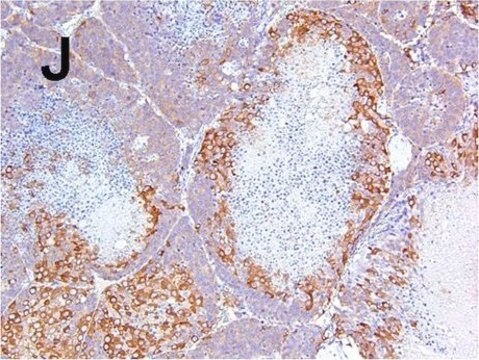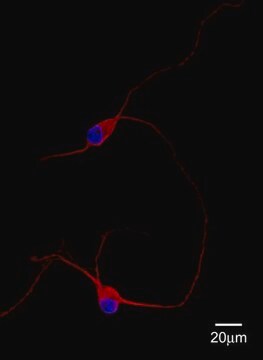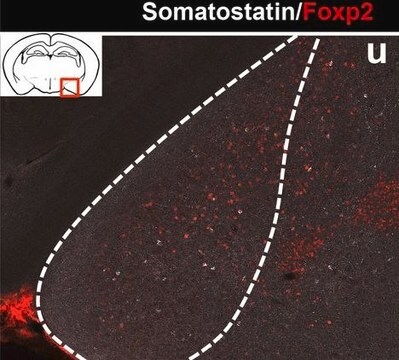MAB1637
Anti-Tubulin Antibody, beta III isoform, CT, clone TU-20 (Similar to TUJ1)
ascites fluid, clone TU-20 (Similar to TUJ1), Chemicon®
Synonym(s):
Tubulin beta-III, tubulin, beta 3, tubulin, beta 4
About This Item
Recommended Products
biological source
mouse
Quality Level
antibody form
ascites fluid
antibody product type
primary antibodies
clone
TU-20 (Similar to TUJ1), monoclonal
species reactivity
rat, mouse, avian, human, bovine, monkey, pig, sheep
manufacturer/tradename
Chemicon®
technique(s)
ELISA: suitable
immunocytochemistry: suitable
immunohistochemistry (formalin-fixed, paraffin-embedded sections): suitable
immunoprecipitation (IP): suitable
western blot: suitable
isotype
IgG1
NCBI accession no.
UniProt accession no.
shipped in
dry ice
target post-translational modification
unmodified
Gene Information
human ... TUBB3(10381)
General description
Specificity
Immunogen
Application
On formalin fixed frozen or paraffin embedded tissue sections: 1:20 to 1:100 dilution from a previous lot. High temperature citrate buffer antigen retrieval is recommended with paraffin embedded tissue sections.
Immunoprecipitation:
A previous lot of this antibody was used on Immunoprecipitation.
Immunocytochemistry:
1:100 to 1:500 dilution from a previous lot was used on fixed cells.
Immunoblotting:
1:1000. Antibody will detect a single band at 50 kDa corresponding to class III beta-tubulin.
ELISA:
A previous lot of this antibody was used on ELISA.
Optimal working dilution must be determined by the end user.
Neuroscience
Neuronal & Glial Markers
Quality
Western Blot Analysis:
1:1000 dilution of this lot detected tubulin (βIII) on 10 μg of Mouse Brain lysates.
Target description
Linkage
Physical form
Storage and Stability
Handling Recommendations: Upon first thaw, and prior to removing the cap, centrifuge the vial and gently mix the solution. Aliquot into microcentrifuge tubes and store at -20°C. Avoid repeated freeze/thaw cycles, which may damage IgG and affect product performance.
Analysis Note
Positive control: Brain tissue or neurons of any type.
Negative control: Non neural tissue or Astrocytes.
Legal Information
Disclaimer
Not finding the right product?
Try our Product Selector Tool.
recommended
Storage Class Code
12 - Non Combustible Liquids
WGK
WGK 2
Flash Point(F)
Not applicable
Flash Point(C)
Not applicable
Certificates of Analysis (COA)
Search for Certificates of Analysis (COA) by entering the products Lot/Batch Number. Lot and Batch Numbers can be found on a product’s label following the words ‘Lot’ or ‘Batch’.
Already Own This Product?
Find documentation for the products that you have recently purchased in the Document Library.
Customers Also Viewed
Articles
ReNcell neural progenitors are immortalized human neural stem cell lines that can differentiate into neurons, astrocytes sand oligodendrocytes.
Derivation and characterization of functional human neural stem cell derived oligodendrocyte progenitor cells (OPCs) that efficiently myelinate primary neurons in culture.
Protocols
Step-by-step culture protocols for neural stem cell culture including NSC isolation, expansion, differentiation and characterization.
Our team of scientists has experience in all areas of research including Life Science, Material Science, Chemical Synthesis, Chromatography, Analytical and many others.
Contact Technical Service









